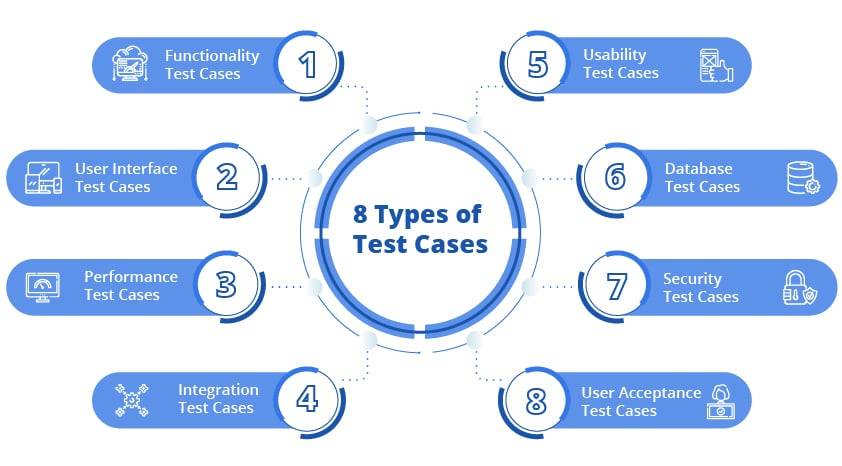Test cases describe the steps to be taken to simulate a user flow. It also contains information about the environment—such as devices, OS and browser. This helps determine if all the features within an application or system are up to par with set standards and expectations.
You, as a tester, should think from the perspective of the user while writing test cases, and cover all important scenarios.
If there is one thing that sets a great tester apart from a mediocre one, that is a test case. Here are the top 8 types so that you don’t miss out any.

1. Functionality Test Cases
These are the most widely used in testing. Their purpose is to check whether an application’s interface is functioning properly. This plays an important role in identifying successes or failures of functions that the client expects software to perform.
These are a type of black-box testing that check for the functionality of the user stories being tested. This enables the checks to be carried out without requiring access to the internal code structure of the software. Functionality test case are usually written by the QA team as the task falls under regular QA processes.
2. User Interface Test Cases
These help verify that Graphical User Interface (GUI) appear and function as per expectations. They help find cosmetic discrepancies, spelling and grammar errors, links and any other elements that the user comes across or interacts with.
It checks how well the system responds to user interaction, while also ensuring that there is no issue with the visuals. This helps testers to gauge whether the applications are functioning according to their requirements. Also, to check if there is no glitch in the interface. Testing teams write these in close collaboration with design teams, as they are the owners of user interface.
3. Performance Test Cases
These authenticate the overall effectiveness and response times of an application. These cases are written once the product team has given the performance requirements ahead. They have a clear criteria.
Testing teams are the ones who write them and they are frequently automated. A larger number of applications may warrant the need for hundreds or thousands of performance tests. Automating these and running them often helps uncover areas where the application is not under-performing.
4. Integration Test Cases
Integration testing is when modules are combined and tested as a group. Modules that have undergone unit checks are taken as input and grouped together. Before being delivered as output, they undergo checks, as have been outlined in the plan.
This particular type helps determine any inconsistencies between integrated software units. It guarantees that the interfaces between different modules are functioning appropriately.
5. Usability Test Cases
The crux here is to assess how usable and easy it is for users to use the application. This one is best left to manual way as it tries to capture the human interaction and is difficult to code in automated testing.
For example, if you are designing a mobile application that allows users to book a cab, you can check for the design and functionality of the app by observing how a user navigates through the process of booking a cab. If he/she is able to move across the different stages smoothly without stumbling in any area, that indicates that your app has been successful. On the other hand, if the user seems to be encountering issues, that would highlight the areas that you need to pay more attention to.
It is carried out time and time again, from the initial stages of development till when the product is released. It assists in guiding the tester through different flows and situations. Crucial to have prior knowledge of the application while working on this.
6. Database Test Cases
Database is where all the information is stored. This ensures that all the information and data stored in the database is correct. It is also known as backend or data testing.
To write good software test cases, you must have a strong understanding of the stored processes, and database tables. The testing team sometimes utilize SQL queries to create database test cases.
7. Security Test Cases
Security test case, as the name suggests, is for testing how secure an application is from malicious cyber-attacks. They often revolve around limits and permissions. These software test cases are used to drive security-based checks and penetration testing.
As a result of security testing, faults and omissions in the software system can be discovered, which, if left unattended, may have resulted in a breach of information and confidential data. Identifying these security risks enables developers to address the flaws and resolve the possible issues through coding, which then helps keep the data safe.
8. User Acceptance Test Cases
These are termed as such because they assist the team to test the application from an end user, often a client, perspective. These types are extensive and cover all areas of the app. The main objective of these isn’t to look for bugs but to verify apps acceptability to the users. In a client and service-provider setting, this forms the basis of work completion on a project (and money to be released).
Now that you have a grasp on the 8 types of test cases, we bet that you are feeling much more confident as a tester–and rightfully so! To make things simpler, a good test case management tool can assist you a great deal, ensuring a smooth process from start to end.
Using such a tool streamlines collaboration among team members and enhances overall efficiency in the execution. Learn more about Kualitee’s software test plan template. With features like centralized repositories, customizable templates, and real-time reporting, these tools empower to organize, prioritize, and execute cases seamlessly. Integration capabilities with other development and evaluation tools further optimize workflow and ensure that the activities align with project objectives and timelines. By making good use of the capabilities of the tool, testers can elevate their effectiveness. They can contribute more effectively to project success, and deliver high-quality software products consistently.


























